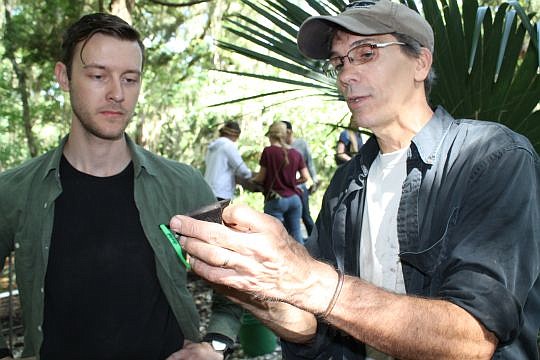
The ancient people who left shell middens on Big Talbot Island were in contact with worlds as far away as the Canadian border.
Hidden facts like these make Keith Ashley excited about the site.
“People have this idea that the natives were just living here by the marsh, fishing and maybe doing a little farming, and that was their whole life,” he said. “During 1,000 A.D. they actually interacted in long-distance networks that stretched to the Ozark Mountains and Lake Superior. They didn’t have a global world, but they still had a broader world around them.”
Ashley is the coordinator of archaeological research for the University of North Florida. It’s a job that allows him to pursue his passion — understanding the lifestyles of native tribes prior to European contact.
He didn’t always know it would be his passion. Ashley initially attended the Auburn University as a civil engineering major.
“I was finishing up one of my last classes, and I had this epiphany — this isn’t what I wanted to do,” he said.
He thought of studying archaeology instead, because he’d always been interested in people who lived in the past, but archaeology wasn’t in his course catalog. It would be weeks before he stumbled onto the school’s archaeology lab and learned the discipline was actually part of the anthropology department.
New studies led to a Ph.D. and a university career that eventually let Ashley study native tribes who had lived near his hometown of Jacksonville.
Now, for six weeks during the summer, Ashley teaches UNF’s archaeological field school. It’s where a portion of his research gets done, and also where students get what is often their first hands-on experience of archeological field work and methodology.
“You see them (the students) get all excited about finding something that no one else has touched in 1,000 years. I still get that way too, even though my interest now is more about what these people were like,” he said.
This summer the team is excavating a trench at the edge of a 65-meter shell ring on Big Talbot Island. The most permanent residents of the island were known only by the period in which they lived — the St. Johns II culture, circa 900 to 1,250 A.D.
The culture is clearly identified by the site’s abundance of shards of check-stamped pottery, which were made by pressing carved wooden paddles into soft clay in a waffle-type design. The site’s time period is confirmed by ground-up sponge skeletons found in the pottery, the preferred tempering material of the time.
Other clues about the St. Johns II lifestyle are scarce, though. There are no living descendants, and the absence of stone locally for a raw material means few surviving artifacts can be found. The best evidence of their existence is the garbage they left behind, which eventually formed into mound architectures.
“We’re trying to decide what kind of garbage this is,” Ashley said. “Is this everyday domestic garbage? Or is this garbage related to larger communal feasting activities?”
Judging from the fact that the midden forms a ring — an unusual shape for the period — and that a burial mound is close by, Ashley reasons it’s a special part of the village and more likely a communal area.
Another central find for Ashley is that some of the artifacts were made from materials not indigenous to the area.
There are ax heads of basalt, taken from Appalachia, and copper from Tennessee, North Carolina and Lake Superior. It tells him the St. Johns II people had ties with tribes that lived far away.
That makes the St. Johns II a more complex society than people usually associate with ancient tribes.
“I like to look at a community’s interactions with people who are not local and to consider how that factored into their development,” Ashley said. “I think the outside world is a big part of who people are and knowing about that that really helps you to understand the total culture.”
(904) 356-2466